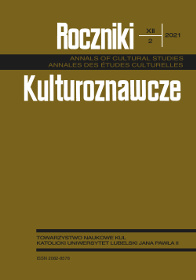The Sacred in the Symbols of Ukrainian Painting at the Turn of the 21st Century
Abstract
Contemporary art as a measure of social consciousness becomes a reference point for finding the boundary between the sacred and the anti-sacred, the aspect that acting as a mirror becomes a reflection of reality, and only at first glance, it speaks of identity but is not true in its essence. Through the semantic key of the symbols of mirroring and reflecting, in the knowledge of the true picture, from divine emptiness to holy fullness, a dialogue of contemporary Ukrainian artists with Kazimir Malevich is formed. The most powerful example of this dialogue is created in the works of Ukrainian classics Oleksandr Dubovyk, Oleksandr Roitburd, and Oleksandr Klymenko. On this path, artists are helped by the heritage of the Ukrainian ethnos, which harmoniously combines the memory of Trypillia culture, national symbols, traditions of icon painting, the school of Mykhailo Boychuk and much more. This article focuses on the sacred in the symbols of contemporary Ukrainian painting that absorbs the most characteristic signs, codes, and ciphers of the previous centuries, transferring spirituality into the 21st century. The transformation of religious symbols into contemporary ones, in consequence of building a discourse with mass culture, generates them into a new cultural code. The semantics of mass culture gives the visual material that forms the sacredness of the 21st century, which exists on the border of the material and the spiritual, as a reflection of the myth. The works of art by Nina Murashkina, Andriy Tsoy, and Mykyta Tsoy are a striking example of that. The sacred in which the mystery of real life is concentrated can endow thinking with a true, rather than an imaginary essence and provide a tool for solving the problem of individuality, freedom, and existence, which the new century is filled with.
References
Agrest-Korotkova, Svitlana. “Oleksandr Dubovyk: I keep putting together the jigsaw puzzle of my picture of the world.” Den, Nov. 7, 2017. Accessed May 11, 2020. https:// day. kyiv.ua/en/article/culture/oleksandr-dubovyk-i-keep-putting-together-jigsaw-puzzle-my-picture-world.
Berdyaev, Nikolai. Filosofiya svobody. Moskva: Put, 1911 | Бердяев, Николай. Философия свободы. Москвa: Путь, 1911.
Buylenkov, Ivan. “Ponyatiye sakralnogo v kontseptsii kultury Viktora Uittera Ternera.” Pivovarovskiye chteniya. Sinteticheskaya paradigma: nauka, filosofiya, religiovedeniye: sbornik materialov konferentsii, 322–24. Ekaterinburg: Delovaya kniga, 2019 | Буйленков, Иван. «Понятие сакрального в концепции культуры Виктора Уиттера Тернера». Пивоваровские чтения. Синтетическая парадигма: наука, философия, религиоведение: сборник материалов конференции. Екатеринбург: Деловая книга, 2019.
Eliade, Mircea. The Sacred and the Profane: The Nature of Religion. Translated by Willard Trask. New York: Harcourt, 1959.
“‘Help me Cheesus’: nova vystavka Andriia ta Mykyty Tsoia | «Help me Cheesus»: нова виставка Андрія та Микити Цоя.” ArtUkraine, November 2, 2018. Accessed April 11, 2020. https://artukraine.com.ua/n/help-me-cheesus--nova-vistavka-andriya-ta-mikiti-coya.
Kryvoruchko, Yuriy. “Mezhi sakralnoho: vyklyky dlia mystetstva.” Patriyarkhat, no. 2 (2019) | Криворучко, Юрій. “Межі сакрального: виклики для мистецтва.” Патріяpxат, № 2 (2019). Accessed October 2, 2020. http://patriyarkhat.org.ua/mezhi-sakralnoho-vyklyky-dlya-mystetstva.
“Nikita Tsoy ‘zzz boo bag doll’.” Facebook, 28 April 2017. Accessed May 12, 2019. www.facebook.com/events/концепт-лаборатория-артерия/никита-цой-zzz-boo-bag-doll/301719893574417.
Osyka, Yana, and Volodymyr Mishenin. “Sakralnoye v sovremennoy kulture: podkhody k opredeleniyu i granitsy ponimaniya.” Nauchnyye vedomosti. Seriya Filosofiya. Sotsiologiya. Pravo 25, no. 16 (2013): 262–67 | Осыка, Яна, Владимир Мишенин. «Сакральное в современной культуре: подходы к определению и границы понимания». Научные ведомости. Серия Философия. Социология. Право 25, № 16 (2013): c. 262-267.
Pavlyk, Parteniy. “Ukrainske sakralne mystetstvo: tradytsii, suchasnist, perspektyvy.” In Ukrainske sakralne mystetstvo: tradytsii, suchasnist, perspektyvy: materialy mizhnar. nauk. konf. (Lviv, Ukraine, May 4–5, 1993), edited by Emmanuyil Mysko, 95–101. Lviv: Svichado, 1994 | Павлик, Партеній. «Українське сакральне мистецтво – традиції, сучасність, перспективи». В Українське сакральне мистецтво: традиції, сучасність, перспективи: матеріали міжнар. наук. конф. (Львів, 4-5 трав. 1993), за ред. Еммануїл Мисько, c. 95-101. Львів: Свічадо, 1994.
“Strila”. In Slovnyk symvoliv. Edited by Oleksandr Potapenko et al. Kyiv: Narodoznavstvo, 1997 | «Стріла». B Словник символів. За ред. Олександрa Потапенка та ін. Київ: Народознавство, 1997. Accessed October 11, 2020.studfile.net/preview/5252915/ page:18.
Sherman, Anna. “Novaya mifologiya Aleksandra Dubovika.” Antikvar, no. 7–8 (2016): 36–43 | Шерман, Анна. «Новая мифология Александра Дубовика». Антиквар, № 7-8 (2016): c. 36-43.
Shmelev, Konstantin. Retsepturnyy spravochnik dlya nachinayushchego vracha. 2nd ed. Saratov: Saratovskoye oblastnoye gosudarstvennoye izdatelstvo, 1942 | Шмелев, Константин. Рецептурный справочник для начинающего врача. Издание 2-е, исправленное и дополненное. Саратов: Саратовское областное государственное издательство, 1942.
Tolstykh, Tatiana. “Serial i nazvaniye bez spoylerov: kiyevskiy khudozhnik rasskazal sekrety svoyey vystavki | Сериал и название без спойлеров: киевский художник рассказал секреты своей выставки.” 44.ua, February 7, 2019. Accessed February 7, 2019. 44.ua/news/2298368/serial-i-nazvanie-bez-spojlerov-kievskij-hudoznik-rasskazal-sekrety-svoej-vystavki.





